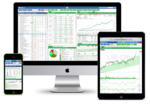Description

FactSet

ActTrader
Comprehensive Overview: FactSet vs ActTrader
FactSet, ActTrader, and Macroaxis are all platforms designed to serve various needs within the financial industry, but they cater to different segments and offer unique features. Here's a comprehensive overview of each:
FactSet
a) Primary Functions and Target Markets:
- Primary Functions: FactSet is a leading provider of financial data and analytics. It offers a wide range of services, including market data, analytics, trading tools, risk management solutions, and reporting tools. FactSet is particularly known for its user-friendly interface, robust data integration capabilities, and comprehensive coverage of global financial markets.
- Target Markets: FactSet primarily serves investment professionals, including asset managers, hedge funds, investment banks, and institutional investors. It is also used by corporate clients for financial planning and analysis.
b) Market Share and User Base:
- FactSet is a major player in the financial data and analytics industry, competing with other giants like Bloomberg and Thomson Reuters (Refinitiv). It has a significant global presence and a large user base comprising predominantly of institutional clients and professional investors.
c) Key Differentiating Factors:
- Integration and Customization: FactSet excels in integrating various data sources and offers highly customizable tools and reports to meet specific client needs.
- Comprehensive Data Coverage: Known for its extensive and reliable coverage of financial instruments across global markets.
- User Experience: Offers an intuitive and seamless user interface, making complex data analysis easier to manage.
ActTrader
a) Primary Functions and Target Markets:
- Primary Functions: ActTrader is a comprehensive trading platform, known for providing brokerage services and trading solutions. It offers tools for forex, CFDs, and cryptocurrency trading with robust features like automated trading, charting tools, risk management, and social trading.
- Target Markets: The platform primarily targets retail and professional traders as well as brokers who need white-label solutions to offer trading services to their clients.
b) Market Share and User Base:
- ActTrader has a more niche market compared to FactSet, focusing on the trading software segment rather than comprehensive financial data services. Its user base consists of both individual traders and brokerage firms looking for customizable trading platforms.
c) Key Differentiating Factors:
- Trading-Focused: Unlike FactSet's broad financial data services, ActTrader is heavily focused on providing trading solutions.
- Customizability for Brokers: Offers extensive white-label services, allowing brokers to brand and modify the trading platform to suit their needs.
- Trading Tools & Automation: Features sophisticated trading tools and supports automated trading strategies.
Macroaxis
a) Primary Functions and Target Markets:
- Primary Functions: Macroaxis is an investment management platform offering portfolio optimization, risk analytics, financial diagnostics, and wealth management tools. It focuses on helping users make smarter investment decisions by leveraging AI and data analytics.
- Target Markets: Targets individual investors, financial advisors, and wealth managers looking for analytics and risk management tools to enhance investment performance and manage portfolios effectively.
b) Market Share and User Base:
- Macroaxis is more focused on individual investors and smaller institutional clients, hence it has a different market position compared to FactSet. Its user base is growing but smaller, appealing particularly to those interested in AI-driven investment insights.
c) Key Differentiating Factors:
- AI-Driven Insights: Offers unique, AI-driven portfolio optimization and risk management features.
- Focus on Portfolio Management: Concentrates specifically on portfolio analytics and optimization rather than a broader set of financial services.
- Engagement with Individual Investors: Positioned more towards individual investors and smaller advisory firms rather than large institutions.
Summary
Each platform differentiates itself by catering to distinct aspects of the financial services industry: FactSet provides comprehensive financial data and analytic services to institutional investors; ActTrader focuses on delivering trading solutions to brokers and individual traders; and Macroaxis specializes in AI-driven portfolio management and investment analytics for individual investors and financial advisors. Their market share and user bases are shaped by the specific needs of their target audiences, with FactSet having the broadest reach among professional investment firms. ActTrader and Macroaxis serve more niche markets with particular focus on trading and portfolio analytics, respectively.
Contact Info

Year founded :
1978
Not Available
Not Available
United States
Not Available

Year founded :
Not Available
Not Available
Not Available
Not Available
Not Available
Feature Similarity Breakdown: FactSet, ActTrader
To provide a thorough comparison of FactSet, ActTrader, and Macroaxis in terms of their features, user interfaces, and unique offerings, let’s dive into each aspect:
a) Core Features in Common
-
Data Analysis and Visualization:
- FactSet, ActTrader, and Macroaxis all provide comprehensive data analysis tools and visualization capabilities. They compile a wide array of financial data for deeper insights through various charts and graphs.
-
Portfolio Management:
- Each platform supports portfolio management, allowing users to track the performance of various investment portfolios and assess risk, strategy, and potential returns.
-
Market Data Access:
- FactSet, ActTrader, and Macroaxis provide access to real-time and historical market data. This includes stock prices, indices, forex rates (more prominent in ActTrader), and other relevant financial metrics.
-
Risk Analysis:
- Tools for analyzing risks associated with investment opportunities are available across all three platforms, helping users make informed decisions.
b) User Interface Comparison
-
FactSet:
- The interface is generally recognized for its comprehensiveness and depth. It is feature-rich but can have a steep learning curve, catering to users with a strong financial background. Customizability and flexibility in data presentation are core strengths.
-
ActTrader:
- This platform is designed to be more intuitive, especially for forex trading. It features a user-friendly interface that appeals to both novice and experienced traders. Advanced charting tools and customizable dashboards are key highlights.
-
Macroaxis:
- Macroaxis offers a user-friendly interface with a focus on simplicity and ease of navigation. It's tailored for investors who may not need the exhaustive detail of FactSet but still require powerful analytical tools. It emphasizes intuitive use and straightforward presentation of analytics.
c) Unique Features
-
FactSet:
- Advanced Analytics & Customization: Highly advanced analytical tools with options for deep customization, automated report generation, and integration with other financial systems.
- Extensive Integration: FactSet offers vast integration capabilities with third-party applications, making it suitable for large financial institutions.
-
ActTrader:
- Forex and CFD Trading: Specialized in foreign exchange (forex) and contracts for difference (CFD) trades. It offers sophisticated tools specifically for these markets.
- Algo Trading: Features algorithmic trading capabilities, providing users with scripting tools to create and deploy their trading strategies.
-
Macroaxis:
- AI and Machine Learning Insights: Leverages artificial intelligence for investment suggestions and risk analytics, potentially appealing to tech-savvy investors.
- Community and Social Investment Features: Provides features for social investing and community engagement, allowing users to share strategies and insights.
In summary, while FactSet, ActTrader, and Macroaxis share some core functionalities in data analysis, portfolio management, and market data access, their interfaces and unique features cater to different segments of the financial market—from institutional research (FactSet) to forex/CFD trading (ActTrader) and simplified investing with AI (Macroaxis). Each platform brings distinct advantages depending on the user's needs and expertise level.
Features

Not Available

Not Available
Best Fit Use Cases: FactSet, ActTrader
When evaluating the best fit use cases for FactSet, ActTrader, and Macroaxis, it's important to consider the distinct features and target audiences each platform addresses. Here's a detailed breakdown:
a) FactSet:
-
Best Fit Use Cases:
- FactSet is a premier choice for financial professionals and organizations that need comprehensive financial data, analytics, and software solutions.
- It's ideally suited for hedge funds, investment managers, private equity firms, and investment banks that rely on global market data, advanced analytics, and risk management tools to make informed investment decisions.
- Businesses working on projects requiring robust financial modeling, performance measurement, and research solutions will benefit significantly from FactSet's capabilities.
-
Industry Verticals and Company Sizes:
- FactSet caters to large financial institutions and mid-sized investment firms.
- Its extensive dataset and analytical tools make it suitable for industries in finance, such as banking, asset management, pension funds, and insurance.
b) ActTrader:
-
Preferred Scenarios:
- ActTrader is specifically designed for retail and institutional traders who need a reliable trading platform with diverse functionalities.
- It is most beneficial for Forex brokers or companies looking to offer Forex, CFD, and options trading services to their clients.
- The platform is suitable for scenarios where traders need customizable solutions for automated trading, risk management, and back-office services.
-
Industry Verticals and Company Sizes:
- ActTrader primarily serves small to large brokerages and trading firms.
- It is particularly tailored for the financial services sector, supporting both individual and institutional trading needs.
c) Macroaxis:
-
When to Consider Macroaxis:
- Macroaxis is best suited for individual investors, financial advisors, and portfolio managers who require easy-to-use tools for asset allocation, risk assessment, and portfolio optimization.
- It's ideal for users seeking a straightforward platform that utilizes advanced algorithms for wealth management and financial planning.
- Projects involving asset evaluation, diversification strategies, or risk minimization can leverage Macroaxis's capabilities effectively.
-
Industry Verticals and Company Sizes:
- Macroaxis targets independent financial advisors, wealth managers, and individual investors.
- Its tools are designed to cater to both small-scale users and larger advisory firms seeking intuitive, analytical support in portfolio management and risk analysis.
In summary, FactSet is ideal for large financial firms needing comprehensive data and analytics; ActTrader is preferred by Forex brokers and trading firms for its robust trading functionalities; and Macroaxis is suited for individual and advisory contexts where portfolio management simplicity is key. These platforms cater to different industry verticals and company sizes, focusing on financial institutions' varying needs.
Pricing

Pricing Not Available

Pricing Not Available
Metrics History
Metrics History
Comparing undefined across companies
Conclusion & Final Verdict: FactSet vs ActTrader
When evaluating FactSet, ActTrader, and Macroaxis, it's important to consider factors such as functionality, cost, user experience, and suitability for specific financial markets or analysis needs. Each product has its own strengths and weaknesses, making them suitable for different user groups.
a) Best Overall Value:
FactSet likely offers the best overall value for institutional investors and larger enterprises due to its comprehensive data coverage, advanced analytics capabilities, and integration options. However, for individual or smaller-scale investors focusing on trading or niche market analysis, Macroaxis or ActTrader might provide better value due to their specialized features and potentially lower cost structures.
b) Pros and Cons:
FactSet:
- Pros:
- Extensive financial data coverage and research capabilities.
- Powerful analytics tools and customizable reports.
- Strong reputation and widely used by institutional clients.
- Integration with third-party tools and platforms.
- Cons:
- High cost, making it less accessible for small businesses or individual investors.
- Steeper learning curve due to the depth of features.
ActTrader:
- Pros:
- Focused on trading and brokerage operations, offering a robust platform for traders.
- Supports automation and customization of trading strategies.
- User-friendly interface geared toward trading professionals.
- Cons:
- May lack the extensive financial data and research tools available from more comprehensive platforms like FactSet.
- Potentially limited in addressing broader financial research needs beyond trading.
Macroaxis:
- Pros:
- Emphasizes investment portfolio optimization and risk management.
- Accessible pricing for individual investors and smaller financial advisors.
- Intuitive tools for visualizing and comparing investment options.
- Cons:
- May not provide the depth of real-time trading tools offered by platforms like ActTrader.
- Limited in terms of advanced research capabilities for institutional investors.
c) Recommendations:
- For Institutional Investors or Large Enterprises: FactSet is the preferred choice, providing the depth and breadth of data and analytics required for comprehensive market analysis and strategic decisions.
- For Active Traders and Brokerage Services: ActTrader might be the most suitable option due to its specialized trading functionalities and user-friendly trading interface.
- For Individual Investors and Financial Advisors: Macroaxis offers valuable tools for managing and optimizing investment portfolios, particularly useful for optimizing return-risk profiles at a competitive price.
Ultimately, the decision should be guided by the specific needs and priorities of the user, such as whether they prioritize detailed market analysis, trading, or portfolio management. Conducting a trial or demo of these platforms, where possible, can also assist in making a more informed decision.



